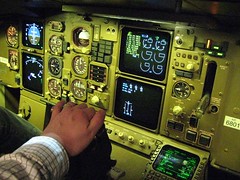A picture of the flight deck of a 757 we got to play with (on the ground) after a class I took on cockpit automation. (Click on the picture for a larger version.) The 757 was developed in the late 70s, and its delivery customer in 1982 was Eastern Airlines. (Remember them?)
I’m not certain, but I believe this was the last Boeing flightdeck to have CRT displays, as opposed to LCDs. The reason this is worth mentioning is that it’s one of those examples of technology going backwards. In CRT displays, the symbols (e.g. the engine arcs in the middle top display) are drawn not as rows and columns of dots, but the same way a person might draw them. For example, a circle is made by scanning the electron beam in a circle, creating a gorgeous, bright, perfect circle. Each letter is written by tracing the beam along the outline of the letter, is if writing it longhand. No pixels! It takes a rather large computer to handle all of this, located deep in the belly of the airplane. Despite being “antiquated” technology, the displays are utterly striking and unlike anything you see today. LCDs may be cheaper, but there’s something about CRTs, especially vector-based ones, that are a pity to see go.
Similarly, there is nothing that can replace the efficacy of analog gauges, in some ways. On the 757 there are still “steam gauges” showing speed and altitude to the left and right of the attitude indicator CRT (the blue and brown ball). They are easy to read, sharp, and wholly independent. I found that when flying the simulator, I would tend to use them over the more central digital speed and altitude “tapes” on either side of the attitude indicator. Integrated LCD panels are cheaper, yes, but I don’t think anybody will ever make one that improves upon the immediate readability of a steam gauge instrument. You can see the approximate angle and rate of change of a dial out of the corner of your eye, but reading a digital number requires eye movement and a bit of mental processing, especially if the numbers are changing rapidly or you’re in turbulence. Two steps forward…
